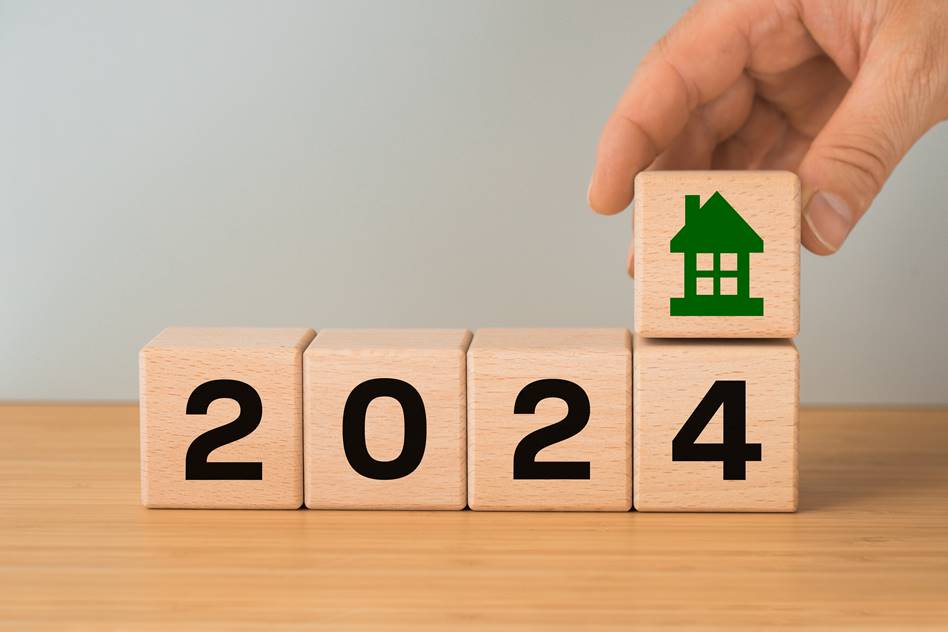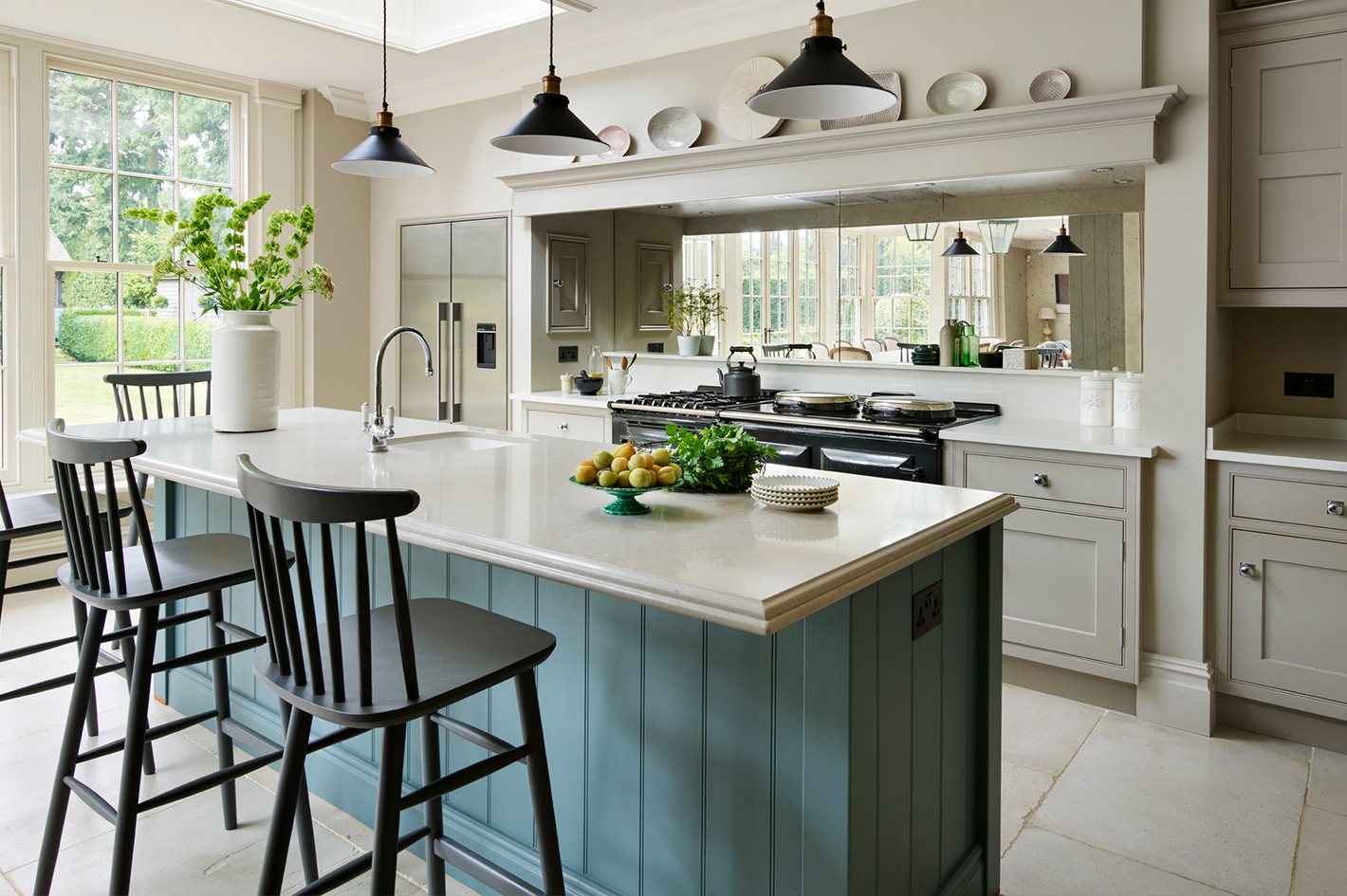Green shoots
As you know, we at Homesite like to make sure we keep you up to date with everything that’s been happening in the property market. And January’s housing data is of particular interest because it provides the first clues to the direction of the housing market for the year ahead. This time around even more so, as the market had been waiting to see how buyers and sellers would react to the reductions in mortgage rates that were occurring at the back end of 2023. The market had already been showing signs of recovery, with Halifax’s monthly figures surprising many commentators by moving into positive territory from October.
January’s figures show that process is now accelerating as nearly two years of pent-up demand is released onto the housing market. Activity has risen across the board. According to Zoopla, buyer demand was up 12% in January when compared to the same period in 2022. Agreed sales were also up (+13%) but in some areas, such as Yorkshire and the Humber, they went even higher at +19%. The number of properties coming to the market has been on the rise, too, with a 22% increase in supplies in January.
Rightmove is also seeing increasing activity levels. Asking prices were up 1.3% in January and, even more significantly, the Mortgage in Principle section on their website has seen record traffic post-Christmas.
Tim Bannister Rightmove’s Director of Property Science says:
”The numbers suggest that many are taking action to make their move in 2024, perhaps including some who paused last year due to the more unsteady mortgage market.”
However, it’s not all good news. Mortgage rates may have come down, but at 4.86% for the average 5-year fixed rate, they are still high compared to the last decade or so and they are unlikely to come down much further this year. It means affordability remains stretched and buyers are seeking discounts.
Zoopla is reporting that a fifth of sellers are having to accept offers that are more than 10% below their asking prices and they advise that ‘sellers must continue to price realistically if they are serious about moving in 2024. Improved market conditions will boost the chances of a sale, but sellers shouldn't expect to list at a higher asking price.’
In better news, is London, where the market had been lagging behind the rest of the country for some time, there is some of the strongest growth in demand. Since Christmas, there have been above-average increases in all areas, from inner and suburban London to the commuter areas.
HOUSE PRICES AND STATISTICS
Monthly growth figures for January vary between +0.7% and +1.3%. Annual rises vary more widely, from -0.7% to +2.5%, but all the indices are showing signs of improvement.
Nationwide: Jan: Avge. price £257,656. Monthly change +0.7%. Annual change -0.2%
Halifax: Jan. Avge. price £291,029. Monthly change +1.3%. Annual change +2.5%
Land Registry: Dec: Avge. price £284,691. Monthly change +0.1%. Annual change -1.4%
Zoopla: Dec: Avge. price £264,400. Annual change -0.8%
Rightmove: Jan: Avge. price £359,748. Monthly change +1.3%. Annual change -0.7% (asking prices on Rightmove)
BUY-TO-LET
As has been the case for some time now, the rental market appears to be on the opposite path to sales. With affordability now stretched to its limit, rents came down yet again last month. Homelet’s data shows the average is now £1,260pcm, a fall of 0.6%, although, on an annual basis, rents remain in positive territory at 7.5%. It is no surprise to find that some of the biggest falls have occurred in London (-2.2%), where rents have soared the highest. Just two years ago, the average rent in the capital was well under £2,000 at £1,760pcm. It is now £2,081pcm, which means a typical London tenant is currently spending over 40% of their income on rent.
Falling mortgage costs have meant that the gap between the cost of renting and buying is closing but it is still considerable. For someone with a 10% deposit, they will pay around 25% more to buy than rent and that is without factoring in having to save for a deposit beforehand. It means, unless mortgage costs fall substantially, there is unlikely to be any reduction in demand for the rental sector.
There are, though, some developments on the legislation front. With an election looming and the Tories trailing Labour, especially with younger voters, Michael Gove is now turning up the pro-tenant rhetoric and is promising to speed up progress on the Renters Reform Bill and No-Fault Evictions. The concern is that he will push through the legislation without providing the required changes in the legal system that are needed to make it work for landlords.
Selling properties Spring
The long nights are finally coming to an end and spring is on its way. It’s one of the busiest times of the year in the housing market and one of the best times to sell your home. However, winter takes a heavy toll on properties and if you want to get the best price in what is a competitive market, it’s best to try and make your place look its absolute sparkling best.
To do that, your checklist should include: the garden – front and back: windows and window frames: doors and door furniture: outside lighting: sheds and greenhouses and any exterior paintwork.
The garden is one of the bigger jobs, so let’s start with that. It may all look a bit daunting at first, but for some instant satisfaction, just have a good tidy-up. Start by sweeping up any lingering autumn leaves, paying special attention to any paths and driveways, then cut away any dead plant matter and give things like roses, hedges and perennials a quick, neatening trim.
If you need to brighten things up, there are a lot more options than you might realise. And, if you buy crocuses and daffodils in pots, you can take them with you when you move. There are also winter flowering pansies, or you could consider Forsythias and primulas to provide some high-impact spring flowers.
Pressure washing your patio is another quick win. If you don’t have a pressure washer, you can always hire one from The Library of Things for just £17.50 a day. It can make a big difference, as patios often get covered in green and black algae over winter. Garden furniture will also need a good scrub down. And don’t forget the barbecue, especially if it never got a clean after its last outing!
The lawn is another important area. Since grass grows throughout the year, it’s probably looking pretty scruffy right now. It’s amazing how much better it’ll look when it’s all neatly trimmed. Make sure you wait for a dry day, though, and cut it on a slightly higher setting than normal. If you give it a bit of a feed and weed at the same time, the nitrogen boost should ensure it goes a nice, tempting green.
It's also worth taking a long hard look at the front of your house and try and imagine how a buyer might see it. Does it have kerb appeal? Or is it all looking a bit scruffy? Be honest because it’s what sets the tone for the entire viewing and so you need to get it right. Trim those hedges, weed those paths and pressure wash the steps. And how about the front door? Is the paintwork sharp and shiny or cracking and peeling? Is the door furniture rusting and tarnished or all new and sparkly? Is there a battery in the doorbell and is the porch light working? If your house is rendered, repair any cracks and repaint if required.
Windows have an affect on both the internal and the external spaces. At this time of year, they are often filthy, which not only looks unattractive, it also cuts down on the light coming into the inside spaces. Give them a good clean or get in a window cleaner to do it for you. At the same time, you could ask them to clean any glass on your sheds and greenhouses. If the window frames are covered in cracking paint, you’ll need to repaint them and make sure you replace any broken panes and all the windows are opening smoothly.
Garden lighting (not solar stuff) is one of those areas that can often get neglected, so make sure it’s in good working order, or people may be suspicious of the quality of the electrics in the rest of the house.
None of this should cost much, just a little time.
Post-Christmas Bounce
For the last couple of years, there has been a serious shortage of stock in the sales market. In November 2020, the average agent had 66 properties on their books. By January of 2023, that number had sunk to just 42, a fall of nearly 40% (source: Rightmove). It may have helped support house prices during some challenging times, but for the market to function properly, buyers need choice. If they don’t, they, in turn, elect not to sell, further exacerbating the problem.
That’s why Rightmove’s report of a record number of sellers listing post-Christmas is such good news. According to the data, on Boxing Day alone, more than 10,000 new properties came onto the market – the largest number in over a decade. Such a pronounced surge in property for sale could have pushed the balance between supply and demand too far. Fortunately, at the same time, traffic on Rightmove’s website also spiked. Visitor numbers were up 273% from the previous day and buying enquiries were up 17% compared to the previous year. The stats are so good that many commentators are now revisiting their predictions for house prices in 2024.
The drivers behind it all are plain to see - many buyers (and sellers) had been sitting tight, while mortgage costs soared. However, at the end of autumn, the base rate finally reached its peak and then, in the run-up to Christmas, lenders started slashing their mortgage rates. Some by as much as 1%. It has not only reduced buyers’ costs, it has also given a substantial boost to the market’s confidence.
Even more encouragingly, it is likely that mortgage rates will continue coming down. although only by small amounts until there is another reduction in the base rate, sometime towards the back end of this year. Those falling mortgage costs also mean that, with rents soaring, there is increasing motivation for tenants to get themselves onto the first rungs of the housing ladder.
Rightmove’s Tim Bannister says:
“The scale of this year’s Boxing Day bounce is an early positive sign at the start of the year that buyers and sellers are out there and taking action, likely including some movers who had put their plans on hold last year.”
if you are thinking of selling, though, you should be aware that the market remains highly price-sensitive. It is still in the early stages of recovery and more choice means more competition between sellers. And buyers are likely to want to negotiate - the average is currently around 5.5%. It means, that if you overprice your property when you first put it on the market, you risk it going stale and that will not only make it harder to sell, but it will also take longer.
Tim Bannister goes adds:
“Accurate and realistic pricing for the local area is the recipe for success for sellers in 2024, and it’s been proven that over-optimistic pricing makes a move much less likely.”
What’s in store for the housing market in 2024?
As a result of inflation and the chaos unleashed by Liz Truss’ mini-budget, many were expecting 2023 to be a challenging year for the housing market. With mortgage costs soaring, quite a few commentators were even forecasting double-digit falls in house prices. However, in the event, the housing market bucked all expectations and there were signs, as of early January, that the housing market would hold steady. Inflation, on the other hand, proved more stubborn than expected. The interest rates, instead of peaking at 4.5%, went on to hit 5.25% and were forecasted, at one point, to reach 6.5%.
Activity, unsurprisingly, was subdued and by the summer, the rising cost of living was generating a wave of strikes and there were fears the economy would suffer. In the housing market, prices fell, but not by much, as many buyers, especially second-steppers, decided to sit tight and wait for mortgage rates to come down. Fortunately, high levels of employment meant that few were forced sales, although ever-rising rents ensured that first-time buyers were the most active in the market.
In August, the base rate climbed to 5.25% but was finally looking like it might have reached its peak. It took buyers several more months to be convinced it wasn’t a temporary blip, but with mortgage costs falling, confidence grew. By November, prices were at last on the move, although sales volumes were low and the market remained highly price-sensitive.
House prices ended the year down but, according to most of the indices, only 1% to 2%. It was the more affordable areas and homes which fared best, with the most expensive areas - the Southeast (-4.5%) and London (-2.3%) - seeing the biggest falls. In contrast, the price of homes in the Northwest rose by 0.3% and in Yorkshire and Humber they were up by 0.1% (source: Halifax). Transaction levels, though, were down by nearly 21% (1m) compared to their long-term average of 1.26m (source: Halifax).
So, what is everyone expecting the housing market to do in 2024? Although the base rate is unlikely to go down until the latter half of 2024, lenders have been busy slashing their rates. The best five-year deals are now under 4% and are expected to fall further, providing a major boost for the housing market. Despite the improvements in borrowing costs, mortgages are still some way above the levels we have become used to. So, in many areas, affordability remains stretched. Most commentators are therefore expecting the market to remain somewhat challenging, with house prices either stagnant or falling slightly, and a return to growth in 2025. There is also an election to factor into this year. They don’t, however, tend to have a huge impact on the market. Historically, there’s nothing more than a slight slowdown just before and just after.
2023: the facts
Nationwide: Dec 22 to Dec 23: National £257,443 -1.8%. London £515,132 -3.8%
Halifax: Dec 22 to Dec 23: National £287,105 +1.7%.
Land registry: Oct 22 to Oct 23: National £287,782 -1.2%. London £516,285 -3.6%
Zoopla: Nov 22 to Nov 23: National £264,500 -1.1%. London £515,504-1.5%
Rightmove: Dec 22 to Dec 23: National £355,177 -1.1%. London £667,019 +0.1% (asking prices).
The predictions
Please note – where possible, comparative figures for 2023 are from the company’s own indices.
Nationwide
Last year, Nationwide said there was likely to be a modest decline of around -5% against a final figure of -1.8%. In 2024, they are expecting the market to remain broadly flat at between 0% and -2%.
Halifax
Halifax’s 2023 prediction of an 8% fall was a long way off their final figure of a rise of 1.7%. This year, they expect prices to fall between 1% and 2%.
Zoopla
In 2023, Zoopla predicted prices would dip by 5%. In the event, their own figures show a fall of just 1.1%. This year they are forecasting prices to come down by a more modest 2%.
Rightmove
At just 2%, Rightmove were expecting one of the smallest falls in 2023, but even that was a little on the pessimistic side - their index ending the year at -1.1%. This year, they have reduced their expected fall to just 1%.
Some other predictions
CBRE forecasted house prices would fall 4.5% by the end of 2023. This year, with the outlook improving, they are expecting a far smaller fall of 0.9%.
Capital Economics were one of the gloomiest last year in their prediction of a 12% fall in house prices. They are considerably more optimistic about 2024, expecting prices to dip by just 1.5%.
Base rate rises again, but mortgages are going in the opposite direction
The base rate may have gone up by another 0.5% to 3.5% this December, but mortgage rates continue to come down. That’s because swap rates (the rate at which banks borrow money) are falling on the back of the money market’s increasing confidence that inflation and interest rates will peak far lower and sooner than had originally been anticipated. Andrew Bailey, Governor of the Bank of England, has even suggested inflation may have already done so.
The latest assumption is that the base rate will now reach a high point of around 4% to 4.5% in the early part of next year rather than 6.25% towards the end of 2023. It has meant that 5-year swap rates have fallen from 5.189% in October to 3.411% in December. To give you an idea of what that all means for mortgages - in December 2021, the average fixed-rate mortgage was as low as 2.34%. Just after the disastrous mini-budget, it shot up to 6.65%. Now the average is down to 5.78% and, at 60% LTV, there are quite a few deals sub 5% (see below). And the gap of nearly 2.4% between the current 5.78% fixed rate mortgages and five-year swap rates suggests there is plenty of room for further reductions.
And commentators are expecting those reductions in fixed-rate mortgages to continue throughout the course of next year, until they settle down to between 4% and 5%, with even lower rates for those with larger deposits. In the short-term, many borrowers are opting for tracker mortgages, especially ones with low or no early redemption fees, allowing them to secure the finance they need whilst hedging against future mortgage falls. When they bottom out, they can then move on to a fixed-rate product.
Below is a selection of this month’s best buys from Moneyfacts.co.uk:
Two-year fixed rates: 4.99% from Generation Home. Product fee £999. 80% LTV.
5.15% from Generation Home. Product fee £999. 85% LTV.
Three-year fixed rates: 4.93% from Coventry BS. Product fee £999. 65% LTV.
5.03% from Coventry BS. Product fee £999. 75% LTV.
Five-year fixed rates: 4.99% from first direct. Product fee £490. 60% LTV.
4.99% from Nationwide. Product fee £999. 60% LTV.
Discounted variable: 3.29% Until 31/01/2025. From Newcastle BS. Product fee £999. 80% LTV.
3.29% For 2 years. From Scottish BS. Product fee £995. 60% LTV.
BUY-TO-LET (BTL)
Best two-year fixed rate: 4.29% from The Mortgage Works. Arrangement 3.00% Advance. 65% LTV.
Five-year fixed rate: 4.69% from The Mortgage Works. Arrangement 3.00% Advance. 65% LTV
Best Discounted variable: 3.74% for 3 years. From Family Building Society. Completion £999 (up to £500k). 60% LTV.
The information we provide is our personal opinion and should not be relied upon for financial advice. Should you need financial advice or guidance please contact an appropriate professional.
People still have to move home
You’ve probably heard it a thousand times before, especially when there’s any kind of blip in the market - ‘people still have to move home, you know,’ your agent will say, but do you believe them? We thought we’d take a look at the numbers behind the statement and see if it really is true. You should know, I am not an agent, I’m a journalist, so I’ve got no axe to grind.
The most common reasons for moving home include: births, deaths, marriages, divorces and retiring/downsizing. And the most reliable place to get the relevant numbers is from the government, the ONS (Office of National Statistics) to be precise, who seem to keep a very close eye on us all.
Births:
Births are one of those things that happen regardless of the state of the economy or the housing market, or, as the cliché goes - the best laid plans. And, I know from experience, once your child has arrived, your one-bedroom flat is going to feel very small indeed. You may last a month or two, telling yourselves you’ll manage. You won’t. Then you’ll have to sell your flat and buy a small house or cottage. And when the next one arrives, you’ll have to sell that and buy a proper, family home. Births therefore create a lot of movement in the market and with around 777,000 of them every year, you’ll get an idea of the scale of it all, especially since they often generate two transactions, rather than one – ie the selling of a home AND the buying of another one.
Deaths:
Well, we all know about death and taxes and their inevitability. Death is certainly no respecter of circumstances, economic or otherwise. There were 586,334 deaths in England and Wales in 2021 (which was some way below average). Like births, they often generate more than one transaction, as the deceased’s house will be sold and the recipients of the money will often upgrade their houses for a bigger or better one.
Divorces:
Sometimes divorcing couples will sell their shared home and buy two new ones. Sometimes one person stays in the existing property and the other buys a new one and sometimes the arguments go on for so long their lawyers get all the money and they end up homeless (only joking). There were 113,505 divorces in 2021, and, if you’re interested, 11 years seems the average duration of a failed marriage.
Retiring/downsizing:
It’s very common to move home when retiring - you no longer need to worry about being near your place of work and with your nest now empty (mostly) you don’t need so much space, either. It is also a point in your life when you feel less at the mercy of the economy, so people move regardless of how it’s performing, including the housing market. Around 700,000 of us pack in full time work every year and that excludes Scotland. Again, this usually creates a double transaction – buying and selling.
Moving for a new job:
Now this is an area which tends to be more dependent on the economy, but even in a downturn, people still change jobs. Exact figures are hard to find, but the CIPD are forecasting that a whopping 6.5 million of us are planning to move jobs over the next 12 months (that's 25% up on this year). Granted, the majority won’t have to move home, but quite a few will and, at those kinds of numbers, they will form a significant proportion of active buyers and sellers.
So, there you go, indisputable proof that agents are telling the truth - there are significant numbers of buyers and sellers regardless of the state of the market.
How much value does a south-facing garden add?
‘’…And a lovely, south-facing garden’ – we’ve all seen the phrase in many a property listing, but how much does a south-facing garden really add to the price of a house?
South-facing gardens are considered more desirable because they get the most sunlight during the course of the day. And, in urban areas, where gardens are smaller, narrower and more shaded, it’s even more important. It is such a big issue that agents now regularly report people using the compasses on their phones during viewings to check the house’s orientation.
Putting a value on it, however, is not that straightforward. Rightmove, fortunately, has done all the hard work, trawling through their extensive data in their search for answers. So what did they find?
Of the 400,000 homes they analysed, the average increase in value was £25,350, or 7%. In London, you’d expect those figures to be even higher, and they were, in financial terms - £60,593 - but in percentage terms they only ranked third, which suggests there is a ceiling to what people are prepared to pay. The keenest gardeners are to be found in Yorkshire and The Humber, which saw the biggest percentage boost of 14%.
| Region | Asking price premium | Price difference |
| Yorkshire & Humber | 14% | £33,931 |
| North West | 12% | £30,613 |
| London | 9% | £60,593 |
| North East | 8% | £14,546 |
| West Midlands | 8% | £22,626 |
| Wales | 6% | £15,252 |
| South West | 6% | £22,608 |
| East Midlands | 5% | £14,056 |
| Scotland | 3% | £5,573 |
| East of England | 2% | £8,277 |
| South East | 2% | £9,443 |
| Average GB | 7% | £25,350 |
During their research Rightmove discovered that south-facing gardens didn’t just affect the price of a house, it also meant the house sold faster. As you might expect, the biggest impact was found to be in places such as Yorkshire and The Humber, where buyers were most keen on south-facing gardens. Those properties sold 8 days faster than the average. Across the country, the figure was 3 days faster.
| Region | Standard time to find buyer | Days saved |
| Yorkshire & Humber | 62 | 8 |
| North East | 57 | 6 |
| West Midlands | 59 | 5 |
| South West | 62 | 4 |
| East of England | 69 | 4 |
| Scotland | 33 | 3 |
| East Midlands | 68 | 3 |
| Wales | 69 | 1 |
| South East | 67 | 0 |
| London | 67 | 0 |
| North West | 63 | 0 |
| Average GB | 61 | 3 |
Rightmove’s Miles Shipside says,
“For as long as I can remember, south-facing gardens have been viewed as the crème de la crème of outdoor spaces among home-hunters.
“It doesn’t mean your house will automatically be worth £25,350 more if it has a south-facing garden as this is an average and it will also depend on the condition and location of your home, but it’s certainly something to shout about in a listing as it could mean your home makes it on to a buyer’s shortlist over another property down the road, or even on the other side of the street.”
Even if your garden is not south-facing, a decent one will still add to the attraction of your home. Whichever way it faces, though, it’s important to make sure you make the most of your outside spaces when you are trying to sell a property, making them look as attractive as possible. That means mowing the lawn, clearing the weeds and repairing and painting fences and sheds. And, at this time of year, that also includes cutting back any dead plants and sweeping away the dead leaves. Any shots you might have of the garden in summer would be very useful, too, as they will help potential buyers see what it looks like in full bloom.
What you need to know about ‘Right to light’
If you, like many of our customers at homesite, are planning on doing any building work on one of your properties - a new extension, or even a shed or a new garden wall - and it obstructs the light to another property, you need to know about the rules surrounding ‘Right to Light’. If you don’t, it could cost you money. ‘Right to Light’ is an area filled with misconceptions. Most people think it is all part of the planning process and only become aware of its true implications when a solicitor’s letter drops through the door in the middle of a project.
If you inadvertently infringe someone’s ‘Right to Light’, you may be forced to alter your building or pay compensation. In some extreme cases, it can even lead to an injunction on any further work. The most high profile cases have involved commercial developments. In recent times, a number of developers have been forced into hugely expensive rebuilds as a result of their failure to address the ‘Right to Light’ of nearby buildings, but even in a domestic context, infringements can have serious consequences.
People assume that ‘Right to Light’ is part of the planning process. Unfortunately, that’s not correct. Planners will sometimes consider it, but the fact is, it’s an entirely separate legal issue - ie Common Law rather than Planning Law. A planning decision has no legal standing in this area. It means that legal action can be taken even if the building work already has planning permission or is covered by permitted development rights.
Under the Prescription Act of 1832, a property owner automatically acquires the ‘Right to Light’ if the building has enjoyed the benefit of the light through defined apertures (ie windows) for an uninterrupted period of 20 years.
This does not mean that the light is entirely protected; the Act only gives you the right to a minimum level. This is measured using some fairly complex formulae, but as a rough rule of thumb, just over half the room should be lit by natural light in a domestic property and a little less in a commercial one. The planners are unlikely to have made any lighting level calculations when assessing a planning application and will probably be totally unaware if there is an infringement of the ‘Right to Light’.
So, what do you need to do if you are on either side of the fence in a dispute over light levels?
If you are the one doing the building, have a think about the likely impact before you begin work. Discuss it with your builder. Are you likely to block light to a neighbour’s window, for example? If you are, you may need some guidance from a specialist surveyor before proceeding. If you are on the receiving end and it's your light that's being reduced, you should also seek expert advice on your best course of action. Any disputes are handled by the courts and the usual outcome is a compensation payment. However, taking someone to court can be very expensive, so it is best to avoid it if you can. Instead, you should attempt to negotiate a mutually acceptable compromise.
The information we provide is our personal opinion and should not be relied upon for legal advice. Should you need legal advice or guidance please contact an appropriate professional.
Underfloor Heating
At this time of year, those kitchen and bathroom tiles are starting to feel a bit chilly and we all dream of underfloor heating and that fabulous warm feeling you get beneath your feet. And, with the rising popularity of heat pumps, underfloor heating seems to be everywhere at the moment. So, does that mean it’s now the most modern and cost-effective way to heat our homes?
Underfloor heating is no fad, it’s been around since Roman times. There are two main types - either water-based or electric. Both systems are highly space efficient, doing away with the need for conventional, wall-hung radiators and replacing them with a system that is housed underneath the floor. And, because they are not trying to transmit heat from just one or two sources (radiators), their heat is far more evenly distributed, enabling them to run at much lower temperatures than a conventional system. They work best when they are used under floor tiles, but can also be placed beneath wood or carpet, provided neither is too thick to allow the heat to pass through. It is recommended that carpet underlay should be no thicker than 1.5 tog and timber, or engineered flooring, should be under 22mm thick. Both systems claim to reduce humidity, which, in turn, reduces the presence of house mites. There is, though, often considerable disruption involved during installation, as you first need to rip out any existing flooring.
So which system is best for you and how much will it cost?
The water-based system is by far the most efficient and can provide energy savings of around 15% when compared to a conventional radiator-based system. In addition, while you are installing it, you will have to insert insulation between the floors, which will also improve the energy efficiency of the rest of the house. They are the only option if you are installing a heat pump, but will also work with an existing conventional boiler, although it will need separate controls as it takes longer to heat up and cool down than conventional radiators. One disadvantage is that its various component parts take up more space than the electric version, so they are not suitable for every type of installation but can, if needed, be fitted between the joists of a suspended wooden floor.
If you have an existing concrete floor, however, you will need to raise the floor levels to accommodate the pipes. This can cause problems with things like door and cupboard heights and is when installers often recommend you use the slimmer electrical version.
According to Checkatrade, installing water-based underfloor heating in an existing home costs £135 to £185 per m2. Electric underfloor heating is considerably cheaper at between £60 to £85 per m2, but as it costs around 3 times more to run, it is likely to increase your energy bill rather than lower it. The electric version is particularly useful in smaller areas, such as compact kitchens and bathrooms. As an added bonus, it is also very quick to install - all the heating elements are integrated into a thin mat, so there is no piping required. You simply roll it out across the floor and then cover it with either tiles or a wooden floor. It can easily be handled by a competent DIYer and then connected to the mains by a qualified electrician.
House price news
After fourteen consecutive rises, the base rate was finally put on hold last month. There is still an outside possibility of one last rise of 0.25%, but all eyes are now on how the housing market will react.
It is too early to see its impact on the various housing indices, as the Bank of England’s announcement didn’t come until the middle of last month. However, as inflation had already shown signs of slowing, confidence in the sector was increasing and there was a slight uptick in asking prices (+0.4%) from the previous month. That is, though, a little below the average for this time of year with prices typically rising by 0.6% as activity ramps up after the summer hiatus. Annually, prices fell from -1.9% to - 0.4%.
It will be some time before all the changes in the base rate fully feed through the system. Many of those with five-year fixed-rate mortgages haven’t experienced any changes whatsoever in their mortgage costs, whereas first-time buyers and anyone coming to the end of their deals have been at the brunt end of it.
In the interim, there has been a bit of a stand-off, with sellers remaining reluctant to offer discounts and buyers waiting for mortgage rates to fall. It means sales volumes were down by 18% this July (latest available figures) when compared to pre-pandemic 2019. Sellers are now finally showing signs of adapting to the situation, with 36.3% of properties currently for sale having had a price reduction, at an average of £22,700 or 6.2%. And, according to another property listings portal, Zoopla, the average discount on the advertised sale price is currently 4.8%.
The price of smaller, more affordable homes is holding up better than it is for larger properties and, as a result, Tim Bannister Rightmove’s Director of Property Science advises:
“Sellers in the middle and upper sectors need to be extra careful not to set their price expectations too high. Plenty of sales are being agreed for properties that are priced at the right level, and those that are selling are still taking five days less than at this time in 2019. We’re also seeing the number of fall-throughs decline as market conditions and mortgage rates stabilise.”
With the economic outlook improving, inflation easing and employment levels high, the pressure to reduce prices much further is limited, so activity may remain a little subdued until the base rate rather than prices start to come down. Most experts believe that may not happen for another 12 months, at which point, we will be in the midst of an election.
HOUSE PRICES AND STATISTICS
Almost all the indices show price falls were moderating in September but, on an annual basis, they continue to slip.
Nationwide: Sept: Avge. price £257,808. Monthly change 0.0%. Annual change -5.3%
Halifax: Aug. Avge. price £278,601. Monthly change -0.4%. Annual change -4.7%
Land Registry: July: Avge. price £289,824. Monthly change +0.5%. Annual change +0.6%
Zoopla: Aug: Avge. price £265,100. Annual change -0.5%
Rightmove: Sept: Avge. price £366,281. Monthly change +0.4%. Annual change -0.4% (asking prices on Rightmove)











